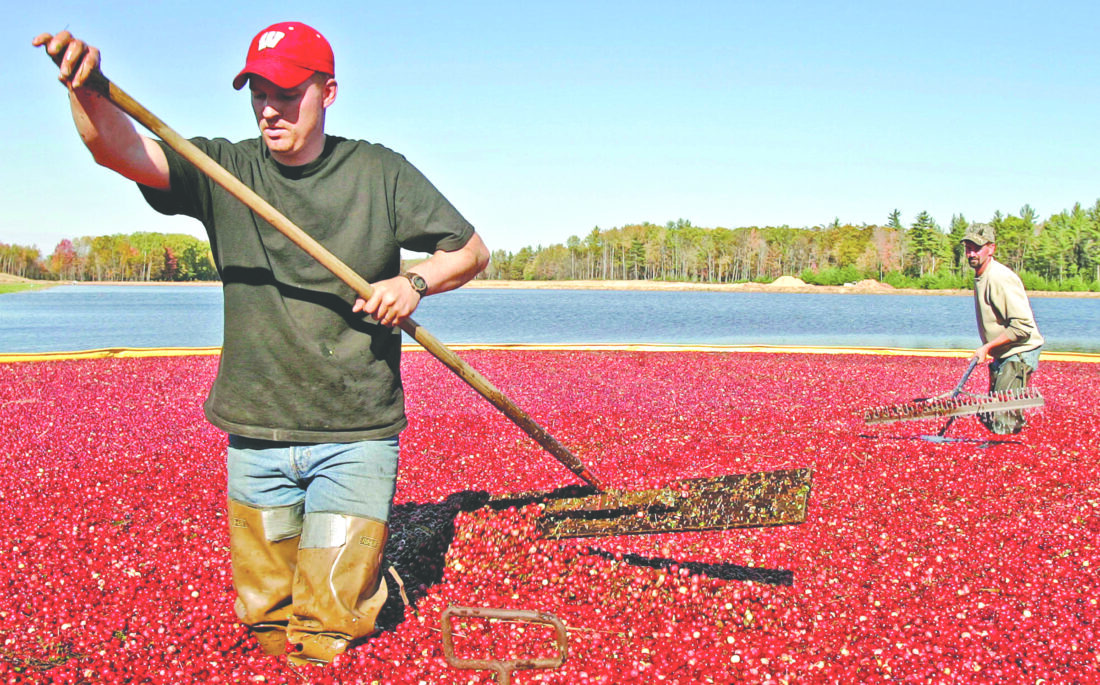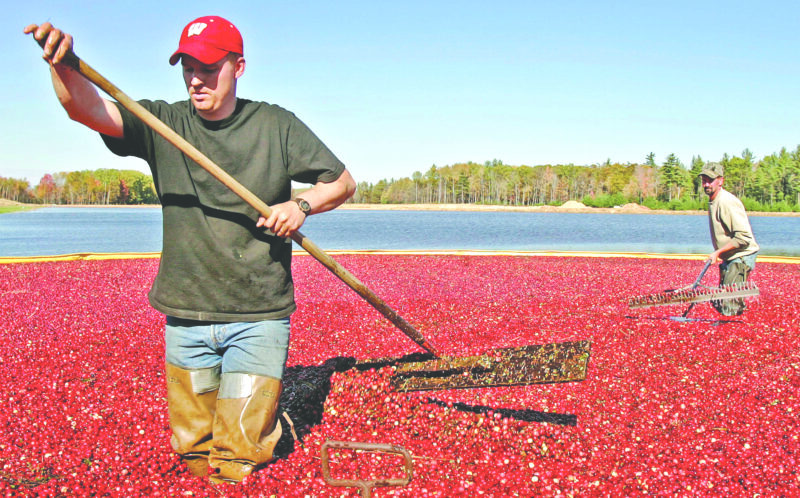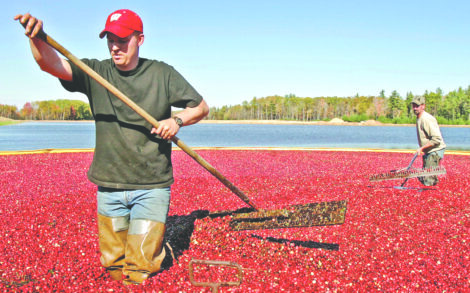Massachusetts tries to keep up with Wisconsin in cranberry production

Jacob Ryan, left, and Trent Lueck use rakes to harvest cranberries in Pittsville, Wis., in October 2005. Wisconsin is the nation's leading cranberry-producing state. (AP file photo)
WCARVER, Mass. — This time of year, cranberry farmers across the country are getting ready to harvest the berries so they can be on Thanksgiving dinner plates.
The king of cranberry states is Wisconsin, which long ago surpassed Massachusetts as the top producer, and bills itself as world’s top producer of the berries that end up in sauce and juices. Most berries will be harvested between September and November.
Massachusetts remains the second-biggest producer but has seen a growing number of farmers retiring their cranberry bogs — marshes that allow the fruit to grow on low-lying vines in beds layered with sand, peat, gravel and clay.
When the cranberries are ready to be harvested, farmers flood their bogs with water and send out a picking machine to shake the berries from the vines. Then more water is added to the bog, and the freed cranberries float to the surface.
Some Massachusetts farmers are choosing to restore bogs back to their native wetlands as the industry is being hit by lower prices for the pinkish crimson berries and the effects of climate change, which is bringing unpredictable weather like droughts and warmer fall conditions that delay the harvest.
Here’s what to know:
A Massachusetts tradition
Cranberry farming in Massachusetts dates back to the 1800s, when farmers replaced native wetlands with bogs often south of Boston and on Cape Cod. The fruit got its name from the Pilgrims, according to Massachusetts Cranberries, the state’s growers association. They called them craneberries because the plant’s pink blossoms looked like the head and bill of a sandhill crane.
The state dominated the industry for decades until Wisconsin became the leader the past three decades.
The projections from the federal Department of Agriculture for 2025 estimates total cranberry production at 8.13 million barrels, down 9% from last year’s crop. Wisconsin was on pace to harvest 5.3 million barrels of cranberries, down 3% from last year. That far outpaces Massachusetts, which is projected to produce 1.75 million barrels, down 22% from last year. That was followed by Oregon at 560,000 barrels and New Jersey at 520,000 barrels. One barrel amounts to 100 pounds.
The strong numbers from Wisconsin, according to Massachusetts Cranberries executive director Brian Wick, coincide with almost all of its farmers planting higher yielding berries, compared with Massachusetts where traditional heirloom varieties are still harvested from about 40% of bogs. The higher yielding berries are bigger and thus more profitable.
Challenging times
The industry is being hit by lower prices for the berries with the rising cost of producing larger, hybrid varieties. Farmers also are seeing the effects of climate change, which is bringing unpredictable weather like droughts and warmer fall conditions that delay the harvest.
In Massachusetts, cranberry farmers on average are over 60 and often are not being replaced when they retire. Much like farming in general, the younger generation is not interested in the long hours and physical demands that come with managing a bog, Wick said.
Benefits of restoration
A growing number of Massachusetts farmers have turned to conservation because they want to keep the land relatively wild but also because there is more federal, state and local funding for those efforts. That money covers the cost of conserving the land and pays for restoration efforts.
In Wisconsin, th e Wisconsin Department of Natural Resources helps to identify landowners with wetland who are willing to sell credits to developers. As part of their projects, these developers need to offset the losses of wetlands from their own projects.
e Wisconsin Department of Natural Resources helps to identify landowners with wetland who are willing to sell credits to developers. As part of their projects, these developers need to offset the losses of wetlands from their own projects.
The concept, however, has been slow to take hold among cranberry farmers, where only four bogs have been restored to natural wetlands.
___
Associated Press journalist Todd Richmond in Madison, Wisconsin, contributed to this report.


